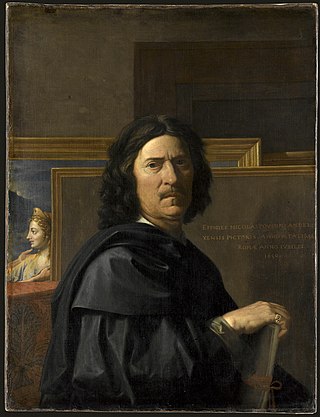
Nicolas Poussin was a French painter who was a leading painter of the classical French Baroque style, although he spent most of his working life in Rome. Most of his works were on religious and mythological subjects painted for a small group of Italian and French collectors. He returned to Paris for a brief period to serve as First Painter to the King under Louis XIII and Cardinal Richelieu, but soon returned to Rome and resumed his more traditional themes. In his later years he gave growing prominence to the landscape in his paintings. His work is characterized by clarity, logic, and order, and favors line over color. Until the 20th century he remained a major inspiration for such classically-oriented artists as Jacques-Louis David, Jean-Auguste-Dominique Ingres and Paul Cézanne.

Andrea Sacchi was an Italian painter of High Baroque Classicism, active in Rome. A generation of artists who shared his style of art include the painters Nicolas Poussin and Giovanni Battista Passeri, the sculptors Alessandro Algardi and François Duquesnoy, and the contemporary biographer Giovanni Bellori.

The Loves of the Gods is a monumental fresco cycle, completed by the Bolognese artist Annibale Carracci and his studio, in the Farnese Gallery which is located in the west wing of the Palazzo Farnese, now the French Embassy, in Rome. The frescoes were greatly admired at the time, and were later considered to reflect a significant change in painting style away from sixteenth century Mannerism in anticipation of the development of Baroque and Classicism in Rome during the seventeenth century.

Giovanni Pietro Bellori, also known as Giovan Pietro Bellori or Gian Pietro Bellori, was an Italian art theorist, painter and antiquarian, who is best known for his work Lives of the Artists, considered the seventeenth-century equivalent to Vasari's Vite. His Vite de' Pittori, Scultori et Architetti Moderni, published in 1672, was influential in consolidating and promoting the theoretical case for classical idealism in art. As an art historical biographer, he favoured classicising artists rather than Baroque artists to the extent of omitting some of the key artistic figures of 17th-century art altogether.

Saint Jerome Writing, also called Saint Jerome in His Study or simply Saint Jerome, is an oil painting by Italian painter Caravaggio. Generally dated to 1605–06, the painting is located in the Galleria Borghese in Rome.

A Dance to the Music of Time is a painting by Nicolas Poussin in the Wallace Collection in London. It was painted between c. 1634 and 1636 as a commission for Giulio Rospigliosi, who according to Gian Pietro Bellori dictated its detailed iconography. The identity of the figures remains uncertain, with differing accounts.

The Lives of the Modern Painters, Sculptors, and Architects or Le vite de' pittori, scultori et architetti moderni is a series of artist biographies written by Gian Pietro Bellori (1613–96), whom Julius von Schlosser called "the most important historiographer of art not only of Rome, but all Italy, even of Europe, in the seventeenth century". It is one of the foundational texts of the history and criticism of European art.
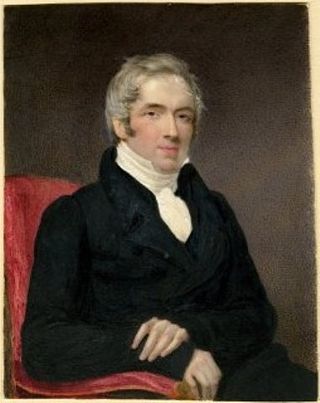
John Smith (1781–1855) was a 19th-century British art dealer who developed the concept of the catalogue raisonné.
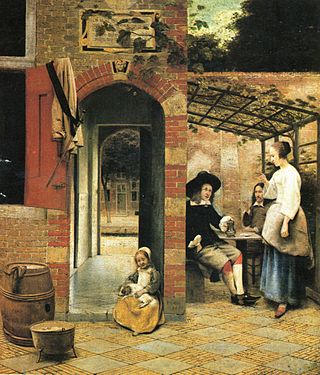
Courtyard with an Arbour (1658–1660) is an oil-on-canvas painting by the Dutch painter Pieter de Hooch; it is now in a private collection. It was sold in 1992 for almost seven million dollars.

The Adoration of the Shepherds is a painting of 1633–34 by the French painter Nicolas Poussin (1594–1665), now in the National Gallery, London. It is in oils on canvas, and measures 97.2 by 74 centimetres. Unusually for Poussin, it is signed "N. Pusin.fe" ["fecit"] on the stone at lower right. By 1637, soon after it was painted, it was owned by Cardinal Gian Carlo de' Medici (1611–1663), the second son of Grand Duke Cosimo II of Tuscany and was placed in his villa outside Florence.
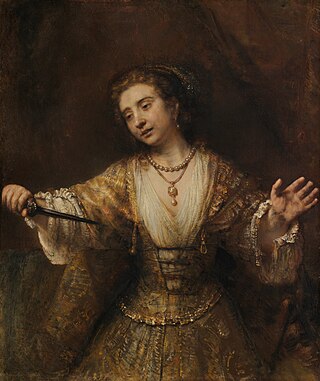
Lucretia is a 1664 history painting of Roman noblewoman Lucretia, historically attributed to the Dutch Golden Age painter Rembrandt in the collection of the National Gallery of Art. In 2015, Ernst van de Wetering of the Rembrandt Research Project said that "the formal properties and execution of [this] painting, I am convinced, exclude the possibility that it could be an autograph work by Rembrandt", and that the painting recalls Aert de Gelder. The painting is not included in the project's 2015 Rembrandt corpus.

Danaë was a 1600-1605 oil on canvas painting by Annibale Carraci, destroyed during World War II. An autograph preparatory study survives in the Royal Collection at Windsor Castle. Prints but no painted copies of it are known.
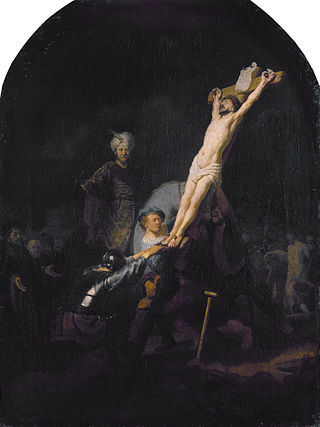
Raising of the Cross is a 1633 painting by the Dutch Golden Age painter Rembrandt in the collection of the Alte Pinakothek. It was painted as part of a "passion" series commissioned in 1633 by Frederick Henry, Prince of Orange. Together with its pendant, The Descent from the Cross, it is one of the rare paintings by Rembrandt with a continuous provenance from the date of completion to today.
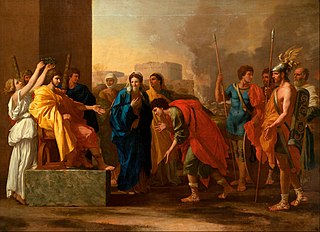
The Continence of Scipio is a 1640 oil on canvas painting by Nicolas Poussin, commissioned by Abbé Gian Maria Roscioli, secretary to Pope Urban VIII. It changed owners several times, reaching the Walpole collection in the first half of the 18th century, from which it was bought for the Hermitage Museum by Catherine the Great in 1779. It was reassigned to the Pushkin Museum in 1930, where it remains. The painting is based on the historical continence of Scipio.
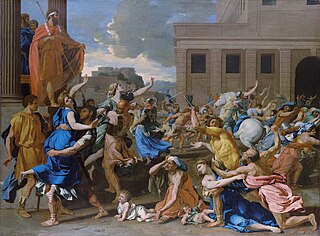
The legendary rape of the Sabine women is the subject of two paintings by Nicolas Poussin. The first version was painted in Rome about 1634 or 1635 and is now in the Metropolitan Museum of Art in New York City, catalogued as The Abduction of the Sabine Women. The second, painted in 1637 or 1638, is in the Louvre in Paris, catalogued as L'enlèvement des Sabines.
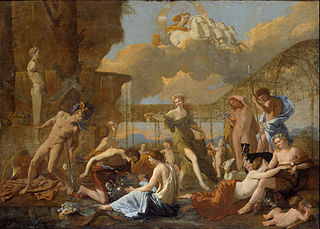
The Empire of Flora is an oil painting by Nicolas Poussin, dated to about 1630 or 1631, which is now in the Gemäldegalerie Alte Meister in Dresden.
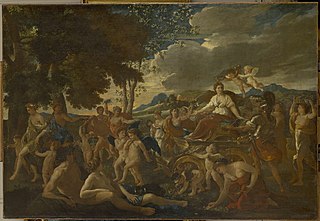
The Triumph of Flora is an oil painting by Nicolas Poussin, dated to about 1627 or 1628, which is now in the Louvre in Paris.
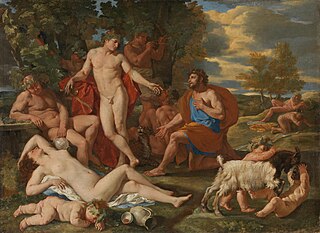
Midas and Bacchus is an oil painting usually attributed to Nicolas Poussin and dated to about 1624–1629, which is now in the Alte Pinakothek, Munich.
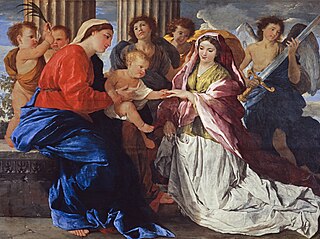
The Mystic Marriage of Saint Catherine is an oil on panel painting by Nicolas Poussin, dated to about 1628–1629, which depicts the mystical marriage of Saint Catherine to Christ. The picture is now in the Scottish National Gallery, Edinburgh.





















